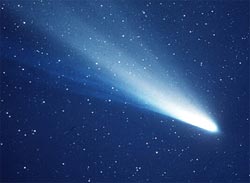Evidence that comets could have seeded life on Earth

Comets like Halley’s can be a breeding ground for complex molecules such as dipeptides. Comets colliding with Earth could have delivered these molecules and seeded the growth of more complex proteins and sugars necessary for life. Courtesy of NASA.<br>
A new experiment simulating conditions in deep space reveals that the complex building blocks of life could have been created on icy interplanetary dust and then carried to Earth, jump-starting life.
Chemists from the University of California, Berkeley, and the University of Hawaii, Manoa, showed that conditions in space are capable of creating complex dipeptides – linked pairs of amino acids – that are essential building blocks shared by all living things. The discovery opens the door to the possibility that these molecules were brought to Earth aboard a comet or possibly meteorites, catalyzing the formation of proteins (polypeptides), enzymes and even more complex molecules, such as sugars, that are necessary for life.
“It is fascinating to consider that the most basic biochemical building blocks that led to life on Earth may well have had an extraterrestrial origin,” said UC Berkeley chemist Richard Mathies, coauthor of a paper published online last week and scheduled for the March 10 print issue of The Astrophysical Journal.
While scientists have discovered basic organic molecules, such as amino acids, in numerous meteorites that have fallen to Earth, they have been unable to find the more complex molecular structures that are prerequisites for our planet’s biology. As a result, scientists have always assumed that the really complicated chemistry of life must have originated in Earth’s early oceans.
In an ultra-high vacuum chamber chilled to 10 degrees above absolute zero (10 Kelvin), Seol Kim and Ralf Kaiser of the Hawaiian team simulated an icy snowball in space including carbon dioxide, ammonia and various hydrocarbons such as methane, ethane and propane. When zapped with high-energy electrons to simulate the cosmic rays in space, the chemicals reacted to form complex, organic compounds, specifically dipeptides, essential to life.
At UC Berkeley, Mathies and Amanda Stockton then analyzed the organic residues through the Mars Organic Analyzer, an instrument that Mathies designed for ultrasensitive detection and identification of small organic molecules in the solar system. The analysis revealed the presence of complex molecules – nine different amino acids and at least two dipeptides – capable of catalyzing biological evolution on earth.
The research was supported by the National Science Foundation and the Mathies Royalty Fund at UC Berkeley.
Media Contact
More Information:
http://www.berkeley.eduAll latest news from the category: Earth Sciences
Earth Sciences (also referred to as Geosciences), which deals with basic issues surrounding our planet, plays a vital role in the area of energy and raw materials supply.
Earth Sciences comprises subjects such as geology, geography, geological informatics, paleontology, mineralogy, petrography, crystallography, geophysics, geodesy, glaciology, cartography, photogrammetry, meteorology and seismology, early-warning systems, earthquake research and polar research.
Newest articles

Properties of new materials for microchips
… can now be measured well. Reseachers of Delft University of Technology demonstrated measuring performance properties of ultrathin silicon membranes. Making ever smaller and more powerful chips requires new ultrathin…

Floating solar’s potential
… to support sustainable development by addressing climate, water, and energy goals holistically. A new study published this week in Nature Energy raises the potential for floating solar photovoltaics (FPV)…

Skyrmions move at record speeds
… a step towards the computing of the future. An international research team led by scientists from the CNRS1 has discovered that the magnetic nanobubbles2 known as skyrmions can be…




















